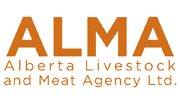Using NIRS to predict fecal starch and grain processing index to improve feed efficiency. (Fact sheet A)
| Project Code: | 2010C008F |
| Completed: | September 2014 |
Project Title:
Research support to the establishment of a NIR network and feeding practices that will lower feed costs and improve net feed efficiency in feedlot cattle – Fecal starch and grain processing index.
Researchers:
Tim McAllister, PhD.
Tim McAllister, PhD., Agriculture and Agri-Food Canada; WenZhu Yang, PhD., Agriculture and Agri-Food Canada; Yuxi Wang, PhD., Agriculture and Agri-Food Canada; Mary-Lou Swift, PhD. Hi-Pro Feeds; Darryl Gibb, PhD. Gowans Feed Consulting.
Feed accounts for as much as 70% of production costs and is second only to fixed costs in terms of importance to the profitability of feedlot cattle production. Consequently, a 5% improvement in feed efficiency has four times the economic value of a 5% improvement in daily gain. This project proposed to focus on those feedlot practices that we believe show the most promise for lowering feed costs and establishing a NIR network that will enable producers to assess feed value. This included utilizing alternative feeds including wheat, specifically formulated feed pellets and high fat by-products or cereal grain sources. The project was linked with proposed programs on NIR adoption in commercial feedlots, large pen production trials organized by Feedlot Health Services, field studies by Hi Pro Feeds and detailed metabolic studies at the University of Saskatchewan. Commercial partners provided input and made the latest technologies available to the research pipeline for assessment and development for the Alberta Feedlot Industry.
Objectives:The overall objective of the research pipeline was to achieve a 4 to 6% reduction in the cost of gain through improved feed efficiency or the use of alternative feeds.
What They Did:Study: Variation of gas production and fermentation with varying barley sources and processing in batch culture - Sixty barley samples including 45 hulled barley and 15 hulless barley were collected from various locations in Alberta. Samples were either ground (1 mm sieve) or dry-rolled with processing index of 80% and fermentability was assessed by measuring in vitro gas production (GP) and dry matter disappearances (DMD) at 0, 4, 8, 14 and 24 h of incubation using batch culture technique.
Study: Using near-infrared spectroscopy to predict the relationship between fecal starch concentration and feed efficiency for feedlot cattle – This study evaluated the relationship between starch content of feces and feed efficiency (G:I) of feedlot cattle.
Study: Effect of wheat vs barley and processing index on growth performance, eating behavior and carcass quality of finishing feedlot steers - Cross breed steers (n=160, BW=538±36 kg) were allocated to 16 feedlot pens (10 per pen and 4 pens per treatment) and fed wheat or barley grain at 89% of diet DM with a processing index (PI) of either 75 or 85 for 12 wk prior to slaughter.
See fact sheet B re: feeding wheat and grain screenings.
What They Learned:The goals as outlined in the original proposal were accomplished as demonstrated by the following achievements:
- Project demonstrated a 7% improvement in feed efficiency with improved processing with barley based feedlots and a 4% improvement with wheat based diets. This range was within or even slightly surpassed the objective of a 4-6% reduction in the cost of gain through improved feed efficiency.
- The project demonstrated the value of NIR through demonstrating its ability to:
- Monitor and improve the processing of cereal grains in finishing feedlot diets and thereby reduce starch excretion in the feces.
- Demonstrate that nutrient loss in feces as measured by NIR was correlated to feed efficiency in feedlot cattle, establishing the potential for this technology to be an indirect indicator of feed efficiency.
- NIR is a useful tool for the prediction of feed value in byproduct feeds. This enabled a sliding scale of value to be developed relative to barley and for feedlot producers to utilize this tool to pay for byproduct feed based on their feed value.
NIR had the ability to predict energy density through estimation of oil content in byproduct feeds.
What It Means:In the study conducted, processing barley from 85 to 75 resulted in a decrease in fecal starch of 10%, leading to a savings of $4.50/hd over a 120 d finishing period. Processing wheat from 85 to 75, led to a decrease in fecal starch of 9%, and a savings of $6.90/hd over the finishing period.

From May 2013 to May 2014, fecal samples were collected from 6 commercial feedlots on a monthly basis, and the average starch content was found to be 6.5%. The table below shows the dollar value per head corresponding to small levels in fecal starch losses relative to the average.

This variability indicates that there is plenty of opportunity for feedlot producers to utilize NIR to estimate fecal starch and adjust processing accordingly to maximize starch utilization. Given the retun of $4.50 per head with an adjustment of the PI from 75 to 85, there is plenty of opportunity for a feedlot to return more than the value on the NIR equipment within a single cycle of a 25,000 head finishing feedlot.








